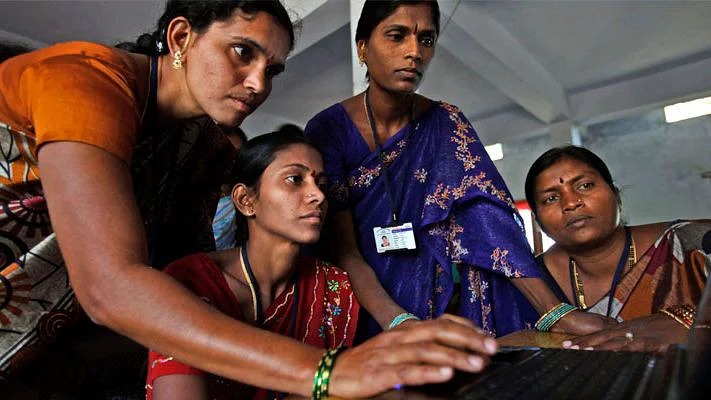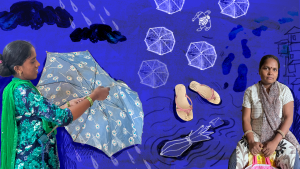As a young PhD student just embarking on research, I was very certain that I wanted to contribute to the field of education economics. After completing my course work, I got a chance to visit Nasik and spend some time with an organisation, Pragati Abhiyan, which worked in the area of rural empowerment and livelihoods. Visiting the rural hinterlands and hearing the stories of people, especially women, in the Maratha-dominated region was my first brush with understanding the challenges women faced in the Indian labour markets.
While most women did not work outside homes due to young children or family restrictions and household work that consumed their time, those who did toil on family fields or managed livestock seldom felt that they really did any meaningful ‘work’ in the usual sense of earning an income for the household. This experience influenced and shaped my research agenda and I decided to work in the field of gender and rural labour markets.
My first academic research work explored the gender wage gap in rural agricultural labour markets. To my surprise, I found that this gap was larger in the south Indian states than in the north. Given that the gender wage gap is often considered an outcome of discrimination, this was striking – literature largely indicated that women were less likely to be discriminated against in the South where they had higher levels of education, health and employment.
My research showed that whereas the regional patterns in the gender wage gap could be explained by demand-supply gaps, wherein an increase in women’s labour supply led to a larger fall in the wages received by them in the South. In economic terms, it meant that labour demand for women was more elastic to their wages, creating a wedge between their employment and earnings. Thus, gender wage and employment gaps could move in opposite directions. This meant that gender-inequality indices that simply used averages of these two could give an inaccurate picture of the gender disparities in the labour market.
In another research, I found that the gender wage gap was also responsive to changes in demand for labour when a region was hit by a drought. Regions which traditionally cultivated rice, a crop where women dominate in the agricultural labour markets due to transplanting and weeding, were likely to see a larger fall in demand for women’s labour in drought years and consequentially, saw a worsening of the gender wage gap.
My other papers on the rural labour markets have explored factors behind the halving of women’s labour force participation in rural India from the 1980s, when it was around 50%, to 2011, when it fell to almost 30%. The analyses showed that while rising incomes and education of husbands could explain the fall in the 1987-1999 period, thereafter it was the mechanisation of agriculture that led to a greater reduction in demand for women workers than for men. Alternative employment opportunities in construction and manufacturing were limited for them due to mobility constraints. All this led to a decline in female participation in the workforce.
Building on this research experience, my recent work explores urban labour markets. I find that in urban markets, it is the gendered division of labour which plays a role in explaining the low and stagnant labour force participation rate of women (of 24%).
I have also been looking into the role played by job ads in the hiring process in contributing to the gender gaps. This research tries to uncover three layers.
First, my co-authors and I look for the presence of explicit gender requests in job ads in India. We find that nearly 7% of job ads mentioned an explicit preference for a male or female candidate. These were likely to be ads for low-skilled jobs but even among these, those that requested a female candidate, offered the lowest wages.
Second, even when an explicit request was not present, through machine learning algorithms we find words that predicted a possible preference for a gender, and again, the posted wages in such jobs were lower when the words indicated female candidate preference. For example, a job ad for software trainee when using words like ‘having complete knowledge of MS Office and friendly with internet, knowing advance english with good grammar’ was predicted to have high female preference while ‘candidates from it/computer science background are preferred, having excellent verbal and written communication skills, should have basic knowledge on IT technologies, quick learners, should be able to work in rotational shifts’ was predicted as having high male preference according to the algorithm.
Third, women were more likely to apply to jobs with an explicit female preference or with higher ‘implicit femaleness’. This led to a gender wage gap at the application stage of about 4%. Given that on average the gender wage gap in urban India within occupations is around 8% (PLFS 2018-19), our research indicates that almost half the gap comes at the application stage itself. Moreover, about 17% of this gap (of 4%) can be explained by the presence of explicit gender requests and gendered words in the job ads which direct male and female applications.
Given that worldwide many countries have banned the specification of gender in job postings, not only does this direct applications in an unfavourable manner but also leads to the perpetuation of gendered stereotypes. Our research shows that India should also implement such a law given that such practices generate a gender gap in the labour markets.
While a multitude of research studies in India have emphasised the role played by childcare and social norms in restricting women’s mobility and have also pointed to the issues of workplace safety, it is now time to move away from what restricts them to what works for them. We hope to see more actionable research on this front.
(The author is currently leading the research on jobs as part of CEDA’s ongoing project to understand and find ways to overcome the demand-side barriers that are keeping women out of the workforce.)





